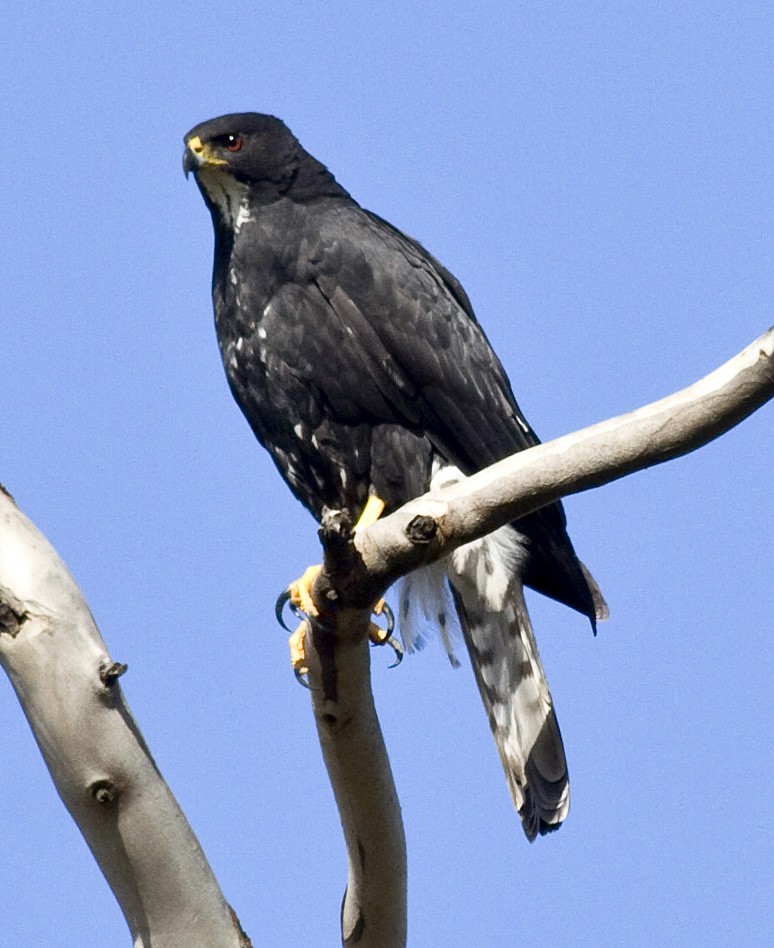Black Sparrowhawk
A species of Bird Hawks, Also known as Great Sparrowhawk Scientific name : Accipiter melanoleucus Genus : Bird Hawks
Black Sparrowhawk, A species of Bird Hawks
Also known as:
Great Sparrowhawk
Botanical name: Accipiter melanoleucus
Genus: Bird Hawks
Content
Description General Info
 Photo By Oggmus , used under CC-BY-SA-4.0 /Cropped and compressed from original
Photo By Oggmus , used under CC-BY-SA-4.0 /Cropped and compressed from original Description
Typically, both sexes of the black sparrowhawk have a predominantly black plumage with a white throat, breast and belly. These white-breasted individuals are known as "white morphs" which are in the majority over most of the birds' range. The "black morph" variety is generally rare, except along the coastal regions of South Africa, including the Cape Peninsula where they constitute 80% of the population. (Black sparrowhawks do not occur more than about 200–300 km north of Cape Town along the South African west coast, where there are almost no trees.) These "black (or dark) morphs", when seen perched, can be black all over, but more commonly have a few white spots on the breast or a white throat of variable size. In flight both morphs show white and black barring on the underside of the wings and tail (see picture). The black morphs are not melanistic, as commonly alleged, as their plumage is not completely black, nor are they black as chicks or juveniles. There is no noticeable difference between the plumage of mature females and males, which can only be distinguished by size. The tails are cross-barred with about three or four paler stripes, and the undersides of the wings with perhaps four or five. The legs are yellow, with large feet and talons. Young chicks have mid-grey eyes and white down, but when the feathers erupt they are predominantly brown. The full plumage of juveniles is a range of browns and russets with dark streaks along the head and, more conspicuously, down the chest. Commonly there are white or light-colored spots and streaks as well, mainly on the wings. The brown plumage being a sign of immaturity, it does not attract as dangerously aggressively territorial behavior as a mature black-and-white bird would. As the young birds mature, their eyes change in color from mid-grey, through light brown, to dark red. 
Size
58 cm
Nest Placement
Tree
Feeding Habits
Black Sparrowhawk predominantly consume mid-sized birds, hunting from concealed perches or during flight. Males favor doves, while females target larger birds like pigeons. Adapted to urban areas, they also prey on poultry and urban doves. Occasionally, black Sparrowhawk eat other raptors and rare small mammals.
Habitat
The black Sparrowhawk thrives in a variety of forested environments, ranging from tropical lowlands to high-altitude montane regions, as well as in exotic plantations. Able to reach elevations up to 3700 meters, black Sparrowhawk is also well-adapted to urban settings such as cityscapes of Cape Town, Yaoundé, and Addis Ababa. In these metropolitan areas, black Sparrowhawk prospers due to an abundance of prey, like pigeons and doves. Urban habitats provide sustenance without diminishing breeding success, and these birds demonstrate a notable flexibility, hunting within a few kilometers of their nests regardless of the season.
Dite type
Carnivorous
General Info
Feeding Habits
Bird food type
Distribution Area
Black sparrowhawks are relatively widespread and common in sub-Saharan Africa and listed as not globally threatened by CITES. Densities range from one pair per 13 square kilometers in Kenya to one pair per 38-150 square kilometers in South Africa. On the Cape Peninsula, however, in the southwestern corner of South Africa, the nest are typically only 500 m (550 yds) apart in the pine plantations and other continuous or semi-continuous belts of trees. Both subspecies are only found in sub-Saharan Africa; A. m. temminckii inhabit much of the northwestern section including Senegal, the DRCongo, and Central African Republic, while A. m. melanoleucus is found from northeastern Africa southwards to South Africa. They naturally inhabit patches of forest, rich woodlands and riverine strips extending into dry bush areas. They can be found in many areas as long as they have large trees, including mangrove forest in coastal Kenya. Especially in southern Africa, black sparrowhawks have adapted to stands of the non-indigenous eucalyptus, poplar, and pine, all of which are grown commercially and are able to grow up to 15 m (49 ft) taller than native trees. Their adaptability to secondary forest and cultivation (they are not uncommon around homesteads now) is one of the reasons why they are not as greatly impacted by deforestation as many African forest birds, and may actually increase in numbers where such stands have been placed in otherwise open country. They are found in elevations from sea-level to 3,700 m (12,100 ft). In some areas, especially on the Cape Peninsula, these sparrowhawks face habitat competition with Egyptian geese (Alopochen aegyptiaca), an aggressive species known to steal the nests of the sparrowhawks. This results in a costly loss for the sparrowhawks after the time and energy spent building the nest and may also lead to the death of current offspring. However, sparrowhawks occasionally have more than 1 nest at a time, or they can readily build a new nest, so, in the event that one is usurped by an Egyptian goose, the pair will sometimes start breeding again in a nearby alternative nest; or they might wait until the geese have left the nest with their goslings, or they abandon breeding for that year. 
Species Status
Not globally threatened.